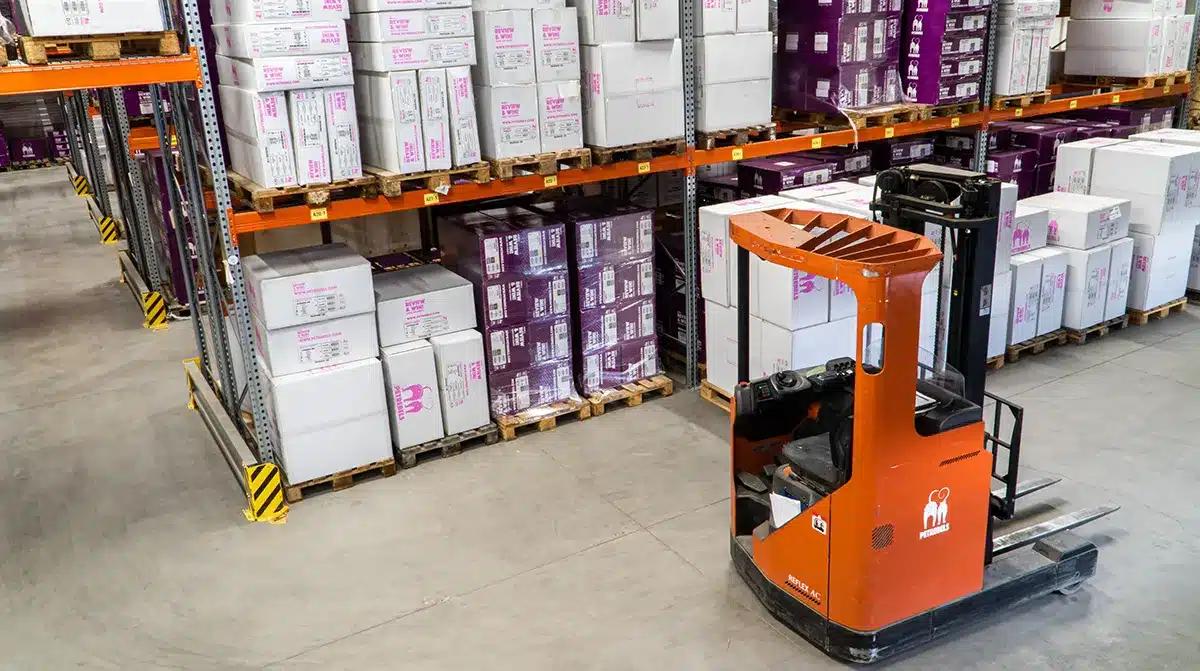Key Takeaways
- Stockouts hurt sales and customer loyalty. When products aren’t available, businesses lose revenue and risk damaging their brand reputation.
- Poor forecasting and lack of visibility are major causes. Inaccurate demand data, manual errors, and delayed replenishment often lead to stock shortages.
- Data-driven inventory planning prevents stockouts. Reliable forecasting and real-time insights ensure the right products are available when customers need them.
Inventory Planner streamlines the process. Its automated forecasting and purchasing recommendations help businesses maintain optimal stock levels and reduce holding costs.
Effective inventory management is crucial for retail and supply chain success. A key component of this is stock balancing, a strategy that ensures the right amount of inventory is available at the right place and time. This practice goes beyond preventing empty shelves or overstocked warehouses; it directly impacts a business’s bottom line.
This blog delves into location-specific stock balancing, a tailored approach that optimizes inventory levels based on the unique demands of each location. We’ll explore how this strategy revolutionizes inventory management, leading to improved customer satisfaction, increased sales, and better operational efficiency. Whether you’re an experienced professional or new to stock balancing, this guide offers valuable insights and practical steps to implement this approach effectively.
What is Stock Balancing?
Stock balancing, also known as inventory rebalancing, is the strategic process of optimizing inventory levels across multiple locations, channels, or product lines to ensure that the right products are available in the right quantities at the right time. This involves redistributing inventory from locations with excess stock to locations with higher demand.
Core Objective of Stock Balancing
The primary goal of stock balancing is straightforward: ensuring that the right amount of inventory is available at the right place and time to meet customer demand while avoiding unnecessary costs. This means avoiding both overstock and stockouts.
Imagine having too much inventory sitting idle on shelves. This overstock not only ties up your capital in unsold goods but also incurs costs for storage, insurance, and potential spoilage or obsolescence. Aging inventory can quickly become a financial drain, cutting off cash flow that could be invested in other areas of your business.
On the flip side, stockouts occur when you run out of a product that customers are actively seeking. This leads to immediate lost sales and a ripple effect of negative consequences. Frustrated customers may turn to your competitors, damaging your brand’s reputation and potentially driving them away for good.
Stock balancing is one way to prevent these problems. It involves carefully analyzing demand patterns across different locations and redistributing inventory accordingly.
Understanding the Importance of Location-Specific Stock Balancing
Not all locations are created equal when it comes to inventory management. Different regions, cities, or even neighborhoods can have vastly different demand patterns, customer preferences, and logistical considerations. That’s why location-specific stock balancing can be a crucial tool for optimizing inventory levels and maximizing your business’s performance.

Factors Influencing Inventory Levels Per Location
- Demand Patterns: Certain products might be more popular in specific regions due to cultural preferences, climate, or local events. Understanding these patterns helps you allocate inventory where it’s most needed to ensure you can meet customer demand.
- Seasonality: Seasonal shifts dramatically alter product demand. For instance, regions with hot summers see a surge in sunscreen sales, necessitating increased stock levels during those months, while areas with milder climates require less stock year-round.
- Customer Demographics: The age, income level, and lifestyle of your target customers can vary significantly between locations. Tailoring your inventory to match these demographics can boost sales and customer satisfaction.
- Transportation Costs: The distance between your warehouse and different locations can affect shipping costs and lead times. These logistical considerations should be factored into your inventory allocation strategy.
Key Metrics for Location-Specific Stock Balancing
To ensure your stock balancing strategy is effective, you need to track and analyze key metrics that provide insights into inventory performance at each location. Here are some essential metrics to consider:
Inventory Turnover
The inventory turnover measures how quickly you sell through your inventory. A high turnover rate indicates that products are selling well, while a low turnover rate might signal overstocking or slow-moving items.
Stock-to-Sales Ratio
The stock-to-sales ratio shows the relationship between your inventory levels and sales volume. A high ratio suggests you might have too much inventory, while a low ratio could indicate potential inventory shortages.
Fill Rate
Fill rate is a key metric that measures a company’s ability to fulfill customer orders promptly from available inventory. A high fill rate means most orders are shipped immediately, while a low fill rate suggests frequent stockouts or delays, potentially leading to lost sales and dissatisfied customers.
Average Days of Supply
The average days of supply help calculate how many days your current inventory will last based on average daily sales. A high number indicates you have ample stock, while a low number could suggest you need to replenish soon.
Using Metrics to Identify Areas for Improvement
- Compare Metrics Across Locations: By comparing the same metrics across different locations, you can identify discrepancies in inventory performance. For example, a high stock-to-sales ratio in one location might indicate overstocking, while a low fill rate in another location could signal the need for increased inventory.
- Track Trends Over Time: Analyze how these metrics change over time to identify patterns and trends. For instance, a declining inventory turnover rate could suggest a need to adjust your product mix or pricing strategy.
- Correlate Metrics with External Factors: Examine how these metrics correlate with external factors like seasonality, promotions, or economic conditions. This can help you understand the underlying causes of fluctuations in inventory performance.
You can gain valuable insights into the effectiveness of your location-specific stock balancing strategy by tracking and analyzing these key metrics. Armed with this information, you can identify areas for improvement, optimize your inventory levels, and ultimately drive greater profitability for your business.
Strategies for Effective Stock Balancing
A well-rounded stock balancing strategy involves utilizing various techniques and adapting them to the unique characteristics of different types of locations. Here are some effective inventory strategies to consider for stock balancing:
ABC Analysis
ABC analysis is a technique that involves classifying inventory items based on their value and sales volume. ‘A’ items are high-value and high-selling products, ‘B’ items are mid-range, and ‘C’ items are low-value and low-selling products. By focusing your efforts on optimizing inventory levels for ‘A’ items, you can have a significant impact on your bottom line.
Safety Stock Optimization
Safety stock acts as a buffer against unexpected demand fluctuations or supply chain disruptions. By calculating the optimal safety stock levels for each location based on historical sales data, lead times, and desired service levels, you can minimize stockouts and ensure smooth operations.
Demand Forecasting
Utilize advanced analytics tools, machine learning algorithms, and automated inventory planning software like Inventory Planner to accurately predict future demand patterns. This allows you to proactively adjust inventory levels based on accurate data, avoiding both overstocking and stockouts and reducing the need for safety stock.
Leveraging Technology for Optimal Stock Balancing
Technology is revolutionizing the way businesses manage their inventory. Software solutions, empowered by data-driven analytics and machine learning, have become crucial tools for achieving optimal stock balancing across multiple locations. These tools fall into two main categories: inventory management software and inventory planning software.
Inventory Management Software
Inventory management software serves as a central command center for all your inventory data, providing real-time visibility into what’s happening with your existing stock. It tracks stock levels, sales trends, inventory turnover, warehouse efficiency, and more across all your locations.
This centralized view empowers you to make informed decisions about inventory replenishment, operational efficiency, and risk management across locations. With features like barcode scanning, RFID tracking, and cycle counting, inventory management software ensures accurate stock data and minimizes the risk of stockouts or overstocks.
Inventory Planning Software
Inventory planning software takes the next step by focusing on what, how much, and when to order new inventory. It leverages historical data, seasonality trends, and external factors to forecast future demand. By understanding how much inventory you’ll need and when you’ll need it, you can make proactive decisions about procurement, production, and distribution.
Features like automated reordering, safety stock optimization, and scenario planning ensure optimal inventory levels across all locations. Algorithms in inventory planning software continuously analyze data in real time and adjust forecasts to provide accurate recommendations to optimize inventory levels and reduce carrying costs.
Implementing Stock Balancing: Step by Step
You might not know where to start when building a stock balancing strategy, especially when dealing with multiple locations with diverse inventory needs. Having a systematic approach and the right tools can simplify this process and create a reliable strategy. Here’s a step-by-step guide to help you get started:
- Gather Your Data: Collect sales data, inventory levels, and other relevant information from all your locations. Use an inventory management system to keep it organized.
- Spot the Trends: Analyze your data to understand demand patterns for different products at different locations. Consider factors like seasonality and customer demographics.
- Predict the Future: Use forecasting tools like Inventory Planner to predict what customers will want, where, and when.
- Set the Right Targets: Determine the ideal stock level for each product at each location, factoring in predicted demand, shipping times, and some extra stock for unexpected situations.
- Keep it Flowing: Set up automatic reordering so your stock levels stay on target. Make sure your suppliers can keep up.
- Stay Alert: Keep an eye on your inventory levels, sales, and forecasting data. If you see differences from what you expected, adjust your plan as needed.
- Work Together: Make sure everyone involved in inventory management and planning is on the same page. Share information and goals so everyone is working towards success.
- Use the Right Tools: Invest in inventory management software and inventory planning software that can help you automate tasks, analyze data, and make informed decisions.
- Review and Improve: Regularly check your plan and make changes as needed based on new information or trends.
Manually executing complicated inventory planning tasks can be incredibly challenging and time-consuming. Gathering data from multiple sources, spotting complex trends, and accurately predicting future demand across various products and locations is a daunting process prone to human error.
This is where advanced inventory planning software like Inventory Planner becomes invaluable. By automating these processes and leveraging over 200+ metrics, Inventory Planner provides accurate, data-driven insights and ordering recommendations. It eliminates the guesswork, reduces manual effort, and ensures your inventory strategy is always optimized for your business’s unique needs and market conditions.
Automated purchasing suggestions
Let Inventory Planner work out your optimal order quantity
Benefits of Stock Balancing with Location Insights
Location insights are the secret ingredient that elevates stock balancing from a good practice to a game-changing strategy. This data-driven approach revolutionizes inventory management by delivering a wide range of benefits across your business:
Meeting Customer Demand with Precision
- Hyper-Local Demand Fulfillment: By understanding the nuances of each location’s demand, you can ensure that the right products are available precisely where and when customers want them.
- Stockout Prevention: Say goodbye to the frustration of empty shelves and missed sales opportunities. Location insights empower you to proactively prevent stockouts, keeping customers happy and your sales flowing.
Striking the Perfect Balance
- Optimized Inventory Levels: Location insights help you walk the tightrope between stockouts and overstocking. You’ll maintain just the right amount of inventory at each location, minimizing waste and maximizing sales potential.
- Cost Control: Avoiding overstock reduces holding costs like storage fees, insurance, and the risk of obsolescence. Meanwhile, preventing stockouts eliminates the need for expensive rush orders and expedited shipping to meet unexpected demand.
Improving Financial Health and Operational Efficiency
- Optimized Cash Flow: Free up valuable capital that would otherwise be tied up in excess inventory. This allows you to invest in growth initiatives, new products, or marketing campaigns.
- Efficient Production Planning: Having the right materials and components on hand at each location ensures smooth production processes and minimizes costly delays.
- Streamlined Operations: Say goodbye to the chaos of emergency orders and last-minute shipments. Location insights streamline your operations, saving you time and resources.
Strengthening Supplier Relationships and Customer Satisfaction
- Enhanced Negotiation Power: Demonstrating consistent and predictable demand through location insights strengthens your position in negotiations with suppliers, potentially leading to better pricing, terms, and relationships.
- Exceptional Customer Service: With products readily available at every location, you can provide faster order fulfillment and on-time deliveries, exceeding customer expectations.
Building Resilience and Adaptability
- Risk Mitigation: Location insights create a buffer against supply chain disruptions. By understanding the unique vulnerabilities of each location, you can proactively manage risks and ensure business continuity.
- Adaptability to Market Trends: Stay ahead of the curve by identifying emerging trends at specific locations and adjusting your inventory accordingly. This allows you to capitalize on opportunities and maintain a competitive edge.
Explore Stock Balancing Solutions with Inventory Planner
Ready to transform your inventory management? Inventory Planner’s comprehensive suite of tools is designed to optimize stock levels and drive profitability across all your locations.
Leveraging advanced forecasting, Inventory Planner accurately predicts future demand patterns. The platform’s intuitive purchasing tools streamline replenishment, automating tasks, and optimizing reorder points. Robust analytics and reporting capabilities provide valuable insights into your inventory performance at each location, enabling data-driven decisions to improve customer satisfaction and efficiency.
Explore Inventory Planner today and discover how it can revolutionize your multi-location inventory management, reduce costs, and maximize sales potential.

